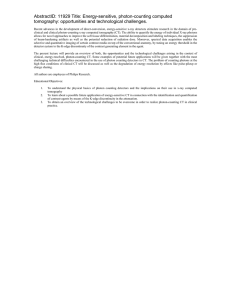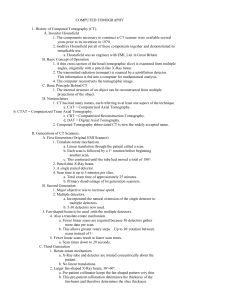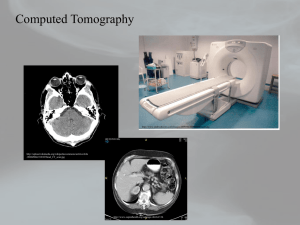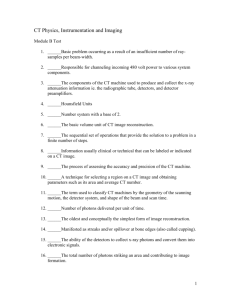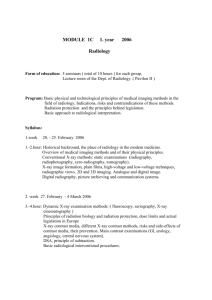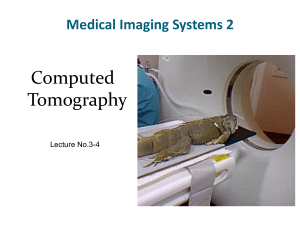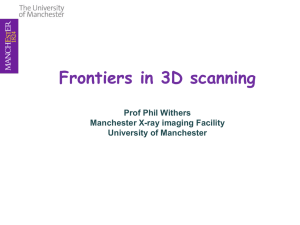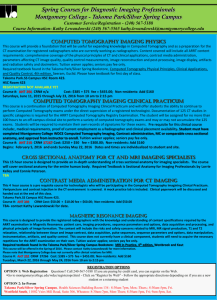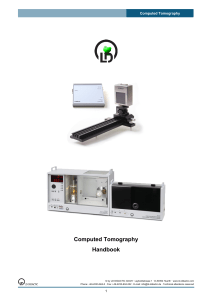Block 10 - Unit 3 - Computed Tomograhy Clinical Applications
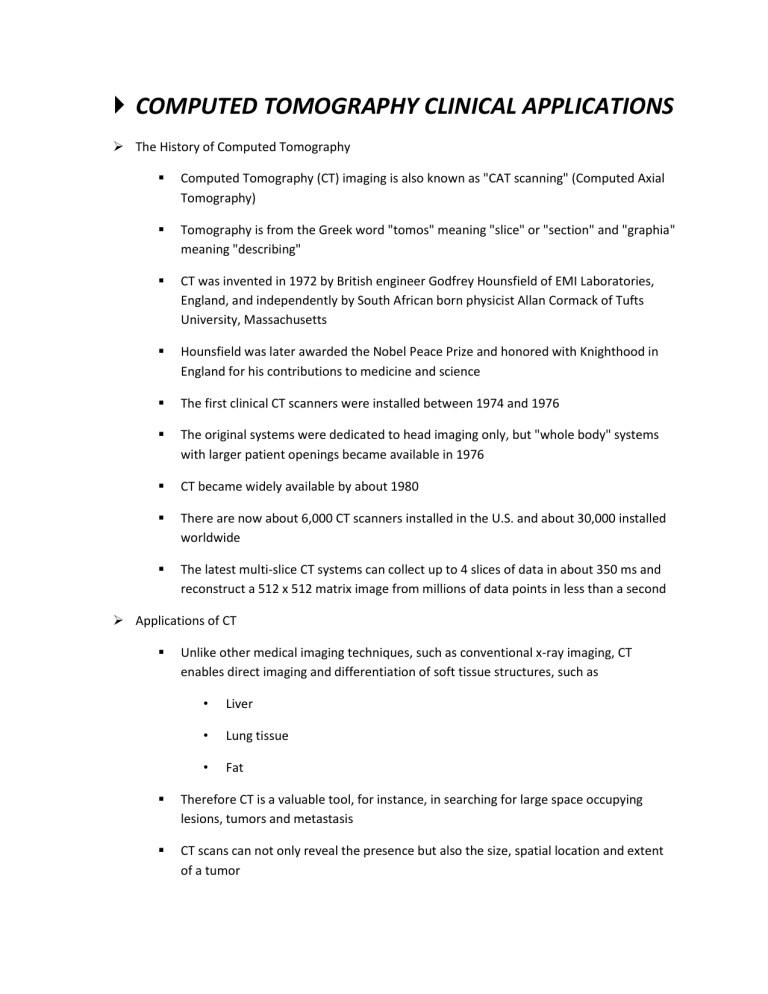
COMPUTED TOMOGRAPHY CLINICAL APPLICATIONS
The History of Computed Tomography
Computed Tomography (CT) imaging is also known as "CAT scanning" (Computed Axial
Tomography)
Tomography is from the Greek word "tomos" meaning "slice" or "section" and "graphia" meaning "describing"
CT was invented in 1972 by British engineer Godfrey Hounsfield of EMI Laboratories,
England, and independently by South African born physicist Allan Cormack of Tufts
University, Massachusetts
Hounsfield was later awarded the Nobel Peace Prize and honored with Knighthood in
England for his contributions to medicine and science
The first clinical CT scanners were installed between 1974 and 1976
The original systems were dedicated to head imaging only, but "whole body" systems with larger patient openings became available in 1976
CT became widely available by about 1980
There are now about 6,000 CT scanners installed in the U.S. and about 30,000 installed worldwide
The latest multi-slice CT systems can collect up to 4 slices of data in about 350 ms and reconstruct a 512 x 512 matrix image from millions of data points in less than a second
Applications of CT
Unlike other medical imaging techniques, such as conventional x-ray imaging, CT enables direct imaging and differentiation of soft tissue structures, such as
• Liver
• Lung tissue
• Fat
Therefore CT is a valuable tool, for instance, in searching for large space occupying lesions, tumors and metastasis
CT scans can not only reveal the presence but also the size, spatial location and extent of a tumor
CT imaging of the head and brain can detect tumors, show blood clots and blood vessel defects, show enlarged ventricles (caused by a buildup of cerebrospinal fluid) and image other abnormalities such as those of the nerves or muscles of the eye
Due to the short scan times of 500 milliseconds to a few seconds, CT can be used for all anatomic regions, including those susceptible to patient motion and breathing
For example, in the thorax, CT can be used for visualization of nodular structures, infiltration of fluids, and fibrosis
CT exams are fast and simple and enable a quick overview of possibly life-threatening pathology and rapidly enable a dedicated surgical treatment. Therefore, CT is becoming the method of choice for imaging trauma patients
The X-ray System
Tube and gantry
• The x-ray tube is mounted on a circular gantry assembly, which rotates around the patient's body
• There are two ways to supply power to the tube while it rotates
Cables
» Designed to only make a couple of rotations
» The gantry must be stopped and rotated in the other direction to uncoil the cables
Sliding electrical contacts (or slip rings) - they permit continuous highspeed rotation
Collimation - two sets of collimators
• One set of collimators determines the angular span of the beam
• The other set of collimators determines the thickness of the beam
Filtration - CT x-ray beams are filter for two purposes
• Beam hardening
In CT imaging the x-ray beam creates an image artifact because of the peripheral tissue is exposed to a lower average photon energy than the inner portion of the slice
This filtration reduces patient exposure by selectivity removing the lowenergy low-penetration part of the x-ray beam
• Compensation
Compensates for the non-uniform thickness of the human body
It is thicker near the edges and is sometimes referred to as the bow-tie filter
Power supply - typically a constant potential type that can produce relatively high KV and MA values for a sustained period of time
Detectors - the radiation receptor is an array of many small detectors that are mounted within the gantry assembly
• Function
Absorbs the radiation it intercepts
Produces an electrical signal proportional to the radiation intensity.
• Configurations
The way in which the detectors are arranged and moved during the scanning process has changed during the evolution of the CT scanner and is different among scanners used today
There are four generations of detector configuration
» First Type
A. Used a single detector element that was moved, along with the tube, in a straight line across the patient's body to form one view
B. Then the tube and detector assembly was rotated 1°and scanned across the body to form the second view
» Second type - used multiple detectors and reduced the number of rotations required to achieve a full scan
» Third type (Rotate-rotate scanner)
A. An array of individual detector elements that is just large enough to form one view is mounted on the gantry
B. It rotates along with the x-ray tube
» Fourth Type (Stationary-rotate scanner)
A. A ring of detector the completely encircles the patient
B. The detectors remain stationary as the tube rotates around the patient
Computer - performs several functions
• Control
After the operator selects the appropriate scanning factors and initiates the scan, the procedure progresses under the control of the computer
It coordinates and times the sequence of events during the scan
» Turning the beam and detectors on and off at the appropriate times
» Transferring data
» Monitoring the system operation
COMPUTED TOMOGRAPHY CLINICAL APPLICATIONS
• Processing - directly involved in the formation of the CT image through processing data into the image
• Storage and retrieval - it transfers, stores, and retrieves images and data
Display unit and camera
• Display unit displays an image on a CRT or video monitor
• Camera converts image to film
CT image formation
The formation of a CT image is a distinct three phase process
The CT image is, for all practical purposes, an image of three densities of the tissue
The scanning phase
• The x-ray beam is scanned around the body
• The amount of radiation that penetrates the body is measured by the detectors and converted into data
COMPUTED TOMOGRAPHY CLINICAL APPLICATIONS
The reconstruction phase
Back projection
The data produced is not a complete image, but a profile of the objects that have been x-rayed
Only enough data in the profile allows the computer to draw in streaks
As the x-ray beam rotates around the body, obtaining different views, we see the beginnings of an image
CT number
A digital image of CT is in the form of a matrix of pixels
A part of the reconstruction phase is to calculate a CT number for each image pixel
Water is the reference material for CT numbers and has an assigned value of zero
Materials with density greater than water will have a positive CT number
Materials that is less dense than water will have a negative Ct number
CT numbers are measured in Hounsfield Units
COMPUTED TOMOGRAPHY CLINICAL APPLICATIONS
The digital to analog conversion phase
The digital image, consisting of a matrix of pixels with each pixel having a CT number, is converted into a visible image represented by different shades of gray or brightness levels by windowing
Windowing controls contrast in CT imaging
The window is the range of CT numbers that will be displayed with the different shades of gray, ranging from black to white
Tissues within the window will have different shades of gray (brightness) and will have visible contrast
All tissues and materials that have CT numbers above the window will be all white and no contrast within this range
All that have CT numbers below the window will be all black and without contrast
The level control adjusts the center of the window
The width control adjusts the range of CT numbers that will be displayed with contrast
The width controls the contrast in the displayed image
Reducing window width increases the displayed image contrast among the tissues
The ability to window is what gives CT a very high contrast sensitivity
This is because a window can be set to display and make visible very small differences in tissue densities
